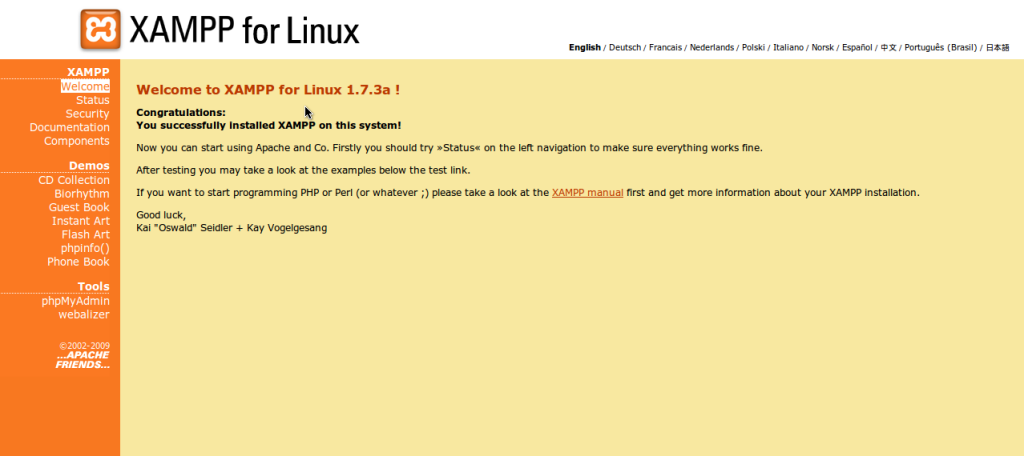

- #Xampp install linux how to#
- #Xampp install linux software#
- #Xampp install linux download#
- #Xampp install linux windows#
So to my first question - If I install Moodle 2.6 on the Linux server and then replace the Moolde files with my old files - will MariaDb ( MySQL), PHP and Apache read the files and "work" or is there another process required to allow this to happen?
#Xampp install linux windows#
I had to take the versions that yum delivered as I am nowhere near being up to the stage of picking and choosing and each of these is a later version of the equivalents I have been running on the Windows Server. I have set up a CENTOS 7 Server and installed the LAMP programs. I have decided to make the jump to Linux. No details to bother you with as this is merely background. I have tried everything that I can find on the Web to try to fix it but with no luck at all. Apache crashes 20 - 30 times a day and it is no longer workable. For example, the database can be easily accessed via the network, and privileged users are not password-protected, etc.I have a 2.6.2 installation of Moodle which has reached the point of no return on a Windows 2003 server. It should be noted, however, that XAMPP is not advised for use as a production server because it sacrifices several security vulnerabilities to facilitate the setup of your development environment. As mentioned above, XAMPP servers are great for development and prototyping servers. This article covers how you can set up your lamp environment with XAMPP. You can also go to and to see that the Apache server and MySQL database are up and running.

This will open the XAMPP window, and you can see all the services and their status in the window. To start the said tool, run the following commands. You can also manage XAMPP services through the GUI tool. Using a Graphical Tool to Manage XAMPP Services sudo /opt/lampp/lampp startĬheck the XAMPP service status at any moment with the following command. You can start the XAMPP service by running the following command in the terminal. Installation should take 10 to 15 minutes, depending on your system.Ĭlick Finish when the installation is completed.Īfter installation, XAMPP files and the new projects you build can be found in the /opt/lampp and /opt/lampp/htdocs directories. Make sure to select both the XAMPP Core and Development files and proceed to installation. Click Next until you are asked to select components of the installation. You will see the setup screen pop up after the command is issued. Start the XAMPP installer using the following command. The XAMPP installer will reside in your navigated folder, but before running it, we need to sort out permissions so that it can become executable using the chmod command. Note: Change the XAMPP version if an updated version is available.
#Xampp install linux download#
Now, run the following wget command to download the XAMPP package from the internet. Download XAMPP for Ubuntuįirst of all, use the cd command to navigate to the folder you want to store or download the XAMPP package for Ubuntu. All the commands in the tutorial will work for any Linux-based system. Note: The methods in this tutorial are implemented on the Ubuntu 20.04 system. You will need terminal access and an account with sudo privileges on the Ubuntu-Desktop system.
#Xampp install linux how to#
This tutorial will show you how to set up a LAMP server using XAMPP on Ubuntu.
#Xampp install linux software#
The XAMPP server is very easy to set up and requires little configuration, which makes it perfect for software development or prototyping. The XAMPP stack can be used to create PHP applications that are driven by frameworks like WordPress, Joomla, Drupal, PrestaShop, and others. XAMPP is made up of Apache, MySQL, PHP, and Perl. It is open-source and supports Windows, Linux, and macOS. XAMPP is a popular LAMP-stack (Linux, Apache, MySQL, and PHP) for building PHP-based web projects.


 0 kommentar(er)
0 kommentar(er)
